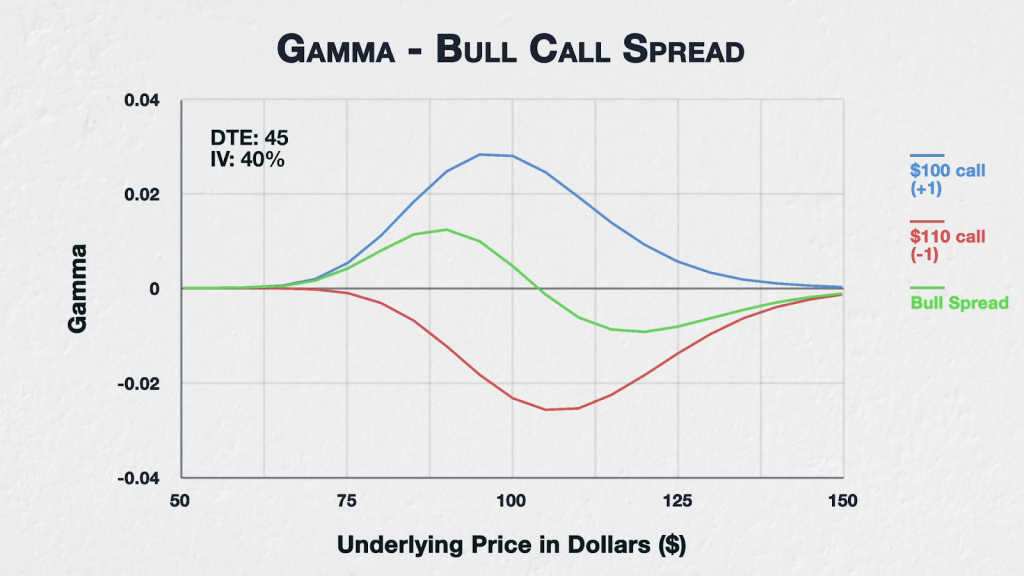So far in this section, we have only discussed the gamma of individual options, but most option traders are likely to have positions/portfolios consisting of more than one option contract at a time, and they will want to know the gamma of their entire portfolio. They will also want to know how their total gamma will evolve as time passes, or as other parameters change, such as the underlying price.
Even though gamma is a second order Greek, just as with the first order Greeks we have discussed so far, it is possible to sum the gamma of each individual option in the portfolio to get the total gamma.
Multi leg example – bull call spread
Let’s look at a simple multi leg option position, a bull call spread. This position consists of purchasing one call option, then selling another call option with a higher strike price, but both with the same expiration date.
This chart shows the gamma of a $100/$110 bull call spread (in green), and of the two individual options that combine to create this spread. The $100 call option (in blue) is purchased, and therefore gives us positive gamma, meaning the delta will increase if the underlying price increases. However, the $110 call option (in red) is sold, and therefore gives us negative gamma, meaning it will decrease our delta as the underlying price increases.

The bull spread line is simply the sum of the gamma for the $100 call long and the $110 call short. Whether the gamma is positive or negative for the spread, depends on where the underlying price is in relation to the strike prices.
Starting on the far left, with the underlying price down at $50-60, both options are so far OTM that the deltas of both have hardly any sensitivity to changes in the underlying price. Gamma is therefore very small for both individual options, and also the spread as a whole.
Moving right to the $65-$95 area, both options are still OTM, but are closer to the money and therefore have picked up some gamma. The $100 strike is of course quite a bit closer and so picks up more gamma sooner. If we take the underlying price of $90 as an example, the long $100 call has a gamma of 0.0250, and the short $110 call has a gamma of -0.0125, which means the spread has a total gamma of 0.0125. The gamma is positive, meaning if the underlying price is sitting at $90, the delta of the spread will currently increase if the underlying price increases.
It is around this underlying price that the rate the gamma of the $100 call is increasing, is outpaced by the increase in gamma of the $110 call. Because of this the gamma of the spread now starts to decrease, though it is still positive for now.
By the time we get to an underlying price of $104 and beyond, the gamma of the spread is negative. This means that the delta of the spread will now decrease as the underlying price continues to increase.
Then finally to the far right of the chart, both options are now deep ITM and their deltas have very little sensitivity to changes in the underlying price. Gamma is therefore small for both individual options, and also the spread as a whole.
We’ve used a vertical spread here, but the same holds true for other spreads, and any other option combination you can think of. Underlying price movement, implied volatility, and time will all still have an effect on the gamma of multi leg option strategies, just as they do for individual options. To get the total gamma for all the legs combined, we can simply sum the gamma for all the individual legs.
Notice also, that even though underlying price changes still have an effect on the spread, because the gamma of each leg partially cancel each other out, the magnitude of the effect of price changes is considerably less than for either of the individual options.
Position size and gamma
To keep things simple we have so far assumed a position size of one. This will rarely be the case in practice so you will often need to know the gamma for positions that vary in size.
To calculate the gamma of a position size that does not equal one, we simply multiply by the position size to give the total gamma of the position.
The bitcoin options on Deribit have a contract multiplier of one, meaning each option contract represents a notional position of one bitcoin. With this in mind let’s look at a few examples of calculating the total gamma, taking into account the position sizes.
For example if you purchase 4 bitcoin call options with a gamma of 0.02 each, the total gamma of your position is 0.08. This is calculated as:
4 * 0.02 = 0.08
This means you would expect the delta of the position to increase by 0.08 if the underlying price increases by $1 and all else remains equal.
If you purchase 16 puts with a gamma of 0.01, and purchase 16 puts with a gamma of 0.02, the total gamma of your position is 0.48. This is calculated as:
(16 * 0.01) + (16 * 0.02)
= 0.16 + 0.32
= 0.48
This means you would expect the delta of the position to increase by 0.48 if the underlying price increases by $1 and all else remains equal.
And finally if you purchase 100 options with a gamma of 0.05, and sell 100 options with a gamma of 0.15, the total gamma of your position is -10. This is calculated as:
(100 * 0.05) + (-100 * 0.15)
= 5 – 15
= -10
Remember we have sold the second leg here, so the position size is -100, rather than just 100. This gives us negative gamma for that leg, and the total position also now has negative gamma. This means you would expect the delta of the position to decrease by 10 if the underlying price increases by $1 and all else remains equal.
In summary
The gamma of a multi leg option strategy is equal to the sum of each of the gammas for the individual options it contains. Remember to also adjust for the position size by multiplying the gamma of the option by the position size.
Course progress update
Next up is a quiz to test what you have remembered about gamma. This will be the last of the sections of this course that deals solely with one of the Greeks. There are many other second and third order greeks, however a detailed study of these is beyond the scope of this introductory course on options. So after the gamma quiz, we will be moving on to the different option strategies that can be deployed, including of course, multi leg option strategies. We will also be covering each of the four Greeks that we have studied so far for each of these strategies.


